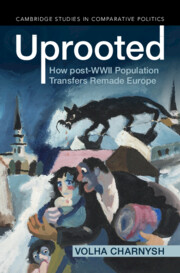Book contents
- Frontmatter
- Contents
- Figures
- Maps
- Tables
- Preface and Acknowledgments
- Abbreviations
- Part I Introduction
- 1 Understanding Forced Migration
- 2 Europe’s Zero Hour: Population Transfers in the Aftermath of WWII
- Part II Social Cohesion and Public Goods
- Part III State Building in the Wake of Displacement
- Part IV Long-Run Economic Consequences of Uprooting
- Appendix A Additional Maps, Figures, and Tables
- Appendix B Sources for Archival and Statistical Data
- References
- Index
- Cambridge Studies in Comparative Politics
2 - Europe’s Zero Hour: Population Transfers in the Aftermath of WWII
from Part I - Introduction
Published online by Cambridge University Press: 07 November 2024
- Frontmatter
- Contents
- Figures
- Maps
- Tables
- Preface and Acknowledgments
- Abbreviations
- Part I Introduction
- 1 Understanding Forced Migration
- 2 Europe’s Zero Hour: Population Transfers in the Aftermath of WWII
- Part II Social Cohesion and Public Goods
- Part III State Building in the Wake of Displacement
- Part IV Long-Run Economic Consequences of Uprooting
- Appendix A Additional Maps, Figures, and Tables
- Appendix B Sources for Archival and Statistical Data
- References
- Index
- Cambridge Studies in Comparative Politics
Summary
This chapter provides the historical background necessary to understand the book’s empirical analysis. It discusses the political decisions that led to the displacement of Germans and Poles at the end of WWII and challenges the assumption that uprooted communities were internally homogeneous. It then zooms in on the process of uprooting and resettlement and introduces data on the size and heterogeneity of the migrant population in postwar Poland and West Germany.
Keywords
- Type
- Chapter
- Information
- UprootedHow post-WWII Population Transfers Remade Europe, pp. 31 - 62Publisher: Cambridge University PressPrint publication year: 2024

